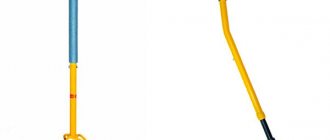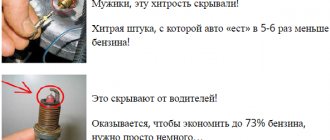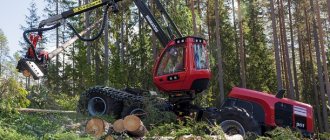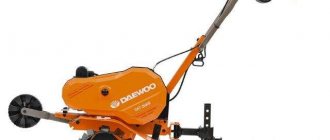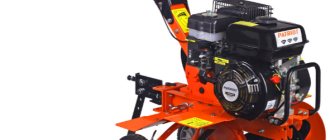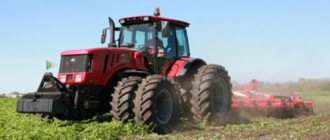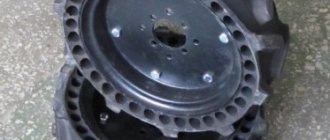Most owners of country and summer cottage plots are happy to cultivate small plots of 4-5 acres, while some of them are content with planting flowers, caring for the lawn, etc. But the majority still prefers to extract practical benefits from their land in the form of potatoes, various vegetables and berries. Today, the gardening equipment market offers a large number of different devices for mechanized tillage and facilitating manual labor. The most popular units include motor-cultivators and motor-blocks.
What is the difference between a walk-behind tractor and a walk-behind cultivator and what to choose?
Land owners often purchase equipment for cultivating land. It increases the speed of gardening and agricultural work and their quality. Before choosing a technique, the question arises about how a walk-behind tractor differs from a walk-behind cultivator.
Both of these units are found in residents’ dachas and gardens. They are sold in large quantities in stores. Each unit differs from its counterparts in characteristics, manufacturing companies and its capabilities. Today we’ll look at them in more detail and try to find out what the difference is between a cultivator and a walk-behind tractor.
Main differences
Equipment for performing agricultural work must be selected with great care and attention. Mechanical and electrical units for cultivating land are expensive. Not every gardener is ready to shell out money for something that turns out to be unnecessary to him. For this reason, it is worth knowing well the difference between a walk-behind tractor and a cultivator.
Externally, both units are similar to each other. They are intended for pre-sowing and harvesting tillage. But they have big differences. A motor cultivator loosens the ground. This operation is needed before planting the future crop. The walk-behind tractor does the same work, but can also clear the area of snow in winter, transport various loads, and split firewood. This is the main difference between a walk-behind tractor and a walk-behind cultivator.
The motor cultivator can be produced with a gasoline or electric engine. It provides many conveniences when processing small areas. The walk-behind tractor is equipped only with a gasoline or diesel engine. It moves on its own wheels with lugs. Among motor cultivators, only powerful units are capable of this. This is another difference that cultivators and walk-behind tractors have.
The engine power of a walk-behind cultivator is less than that of a walk-behind tractor. The capabilities of walk-behind tractors allow you to cultivate hard ground on surfaces with the possible overturning of other machines. The weight of heavy units creates good traction with the soil. The cost of these machines is higher than the cost of cultivators. It is worth buying them for working on large plots of land. The main differences between the machines end there.

The walk-behind tractor is a good assistant for the farmer. He performs the main work, which is difficult. These include:
- plowing the soil;
- cultivation;
- harrowing the site;
- hilling of crops;
- cutting furrows;
- planting crops;
- harvest.
The walk-behind tractor can work on areas of 3-4 hectares. This helps to preserve your health. What is the difference between the units is now clear.
Types of work that the cultivator allows you to perform.
The equipment is capable of performing several types of work on the site, in the garden, so it will help to quickly carry out almost all the necessary work. For this purpose, the equipment has the ability to install additional equipment, which can be purchased additionally if necessary.
Tilling the soil with a motor cultivator and plowing cutters.
The cultivator plows the soil using plowing cutters that rotate the engine through a transmission system. The rotating cutters go deep into the soil, thus ensuring processing and thorough grinding to the full depth. Therefore, the more such cutters are installed on the equipment, the greater the width of the soil, that is, the machine immediately provides processing of a strip of soil to the width at which the cutters are installed; after processing the soil with a cultivator, a processed strip of soil is obtained. As a rule, different models of cultivators provide a processing width with cutters in the range of 50 - 85 cm, which ensures high processing speed of the entire area and good productivity.
But as the working width increases, when installing additional cutters, the load on the cultivator also increases, so it is necessary to correlate the engine power of the equipment with the possible working width. An important indicator is also the diameter of the cutters, since an important characteristic—the depth of soil cultivation—depends on this size. Modern cultivators have a diameter of 32 cm or more, which allows them to plow to a sufficient depth. Thus, a motor cultivator with the help of cutters allows you to quickly and thoroughly cultivate the soil on the site to the required depth, the soil is almost ready for planting seeds, this is a clear advantage of such soil treatment. In addition to plowing with cutters, the cultivator can also perform other types of work related to soil cultivation on the site.
- Hill up plants using a hiller.
- Digs potatoes using a potato digger.
- Certain models of equipment allow plowing the soil with a plow.
- Carry out other work, for example, weeding using special cutters.
Hilling and other types of work using additional equipment.
That is, the cultivator is a universal machine that will help you quickly perform many types of work; this is also an important advantage. Since many jobs in the garden require a large amount of manual labor. A cultivator will help you perform different types of work faster and easier; all you need to do is buy and install various inexpensive additional equipment for certain tasks. If a large area is occupied by potatoes for which it is necessary to hill up at a certain time, then performing such work can also take a lot of effort and time. This work can also be done much faster and easier using a gasoline cultivator.
To do this, it is enough to additionally install a hiller and lugs and quickly hill up the potatoes throughout the entire area. This is inexpensive equipment that has a simple design and can be easily installed on a cultivator. An ordinary metal hiller has a double-leaf shape, with the help of which it plunges into the soil and rake the soil to the sides. Grousers are special metal wheels that provide movement on a loose soil surface; they are installed instead of plow cutters on the same working axis. Thus, the cultivator itself moves on iron lugs as if on wheels, and the hiller carries out hilling by plunging into the soil. To do this, it is enough to control the machine, monitor the direction of its movement and the depth of the hiller’s immersion.
For what kind of work is a heavy-duty motorized cultivator needed?
Also, using a gasoline cultivator, you can perform other work much easier and faster. So, using a potato digger, you can replace manual work with a shovel with faster work using a machine. To do this, it is also enough to install additional lugs and a potato digger. There are also certain models of cultivators that have a special design and special technical characteristics that allow you to plow the soil using a plow. Moving on lugs, such equipment can plow with the help of a plow; this method is used to cultivate very heavy soils when plowing has not previously been carried out. This machine has a special reduction gear, which allows you to apply maximum engine effort at low speeds to perform very heavy work.
Features of walk-behind tractors
A walk-behind tractor is a tractor, a combine harvester, working on its own plot of land. The high power of such machines allows you to install various attachments on them. It is used to remove snow and debris and transport cargo. Potatoes are also planted and harvested along with other root crops. The walk-behind tractor has big differences. It costs more than a cultivator. The final price depends on the type of engine, its power, and the manufacturer's plant. But the brand is not always the main difference.
It is better to listen to customer reviews when choosing a unit.
To cultivate large areas of land, powerful machines are required. All of them are equipped with a power take-off shaft. In areas with poor soil, heavier units should be used. Wheel weights are sold to increase weight. Among the features of the product is the width that the block covers during operation. The delivery set includes cutters that can be installed and removed. This allows you to change the working width.
Gasoline is expensive today. It is recommended to purchase gasoline machines for areas with a small area. In large areas, diesel units do a better job. The disadvantages of a diesel engine include a large amount of noise and difficulties associated with freezing of diesel fuel in cold weather.
Various mounted implements are sold for cultivating dacha and farm plots. They are designed for cultivating the soil, for cleaning the territory, for watering, for moving goods, for planting and harvesting crops.
Walk-behind tractor
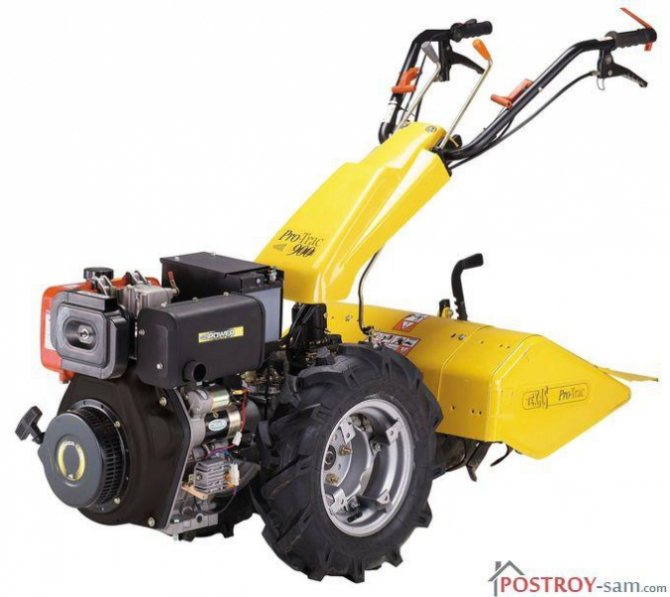
Using this device, you can also quickly cultivate the soil, but its functionality does not end there, since the walk-behind tractor is also intended for other agricultural work. With its help you can mow grass, plant and harvest potatoes. In addition, the walk-behind tractor is capable of digging and hilling the soil, as well as removing crops from the garden.
Drawing a conclusion from the above, we can say that a walk-behind tractor is a more functional device than a cultivator. Currently on the market you can buy walk-behind tractors with a wide variety of functionality - with knives designed for digging ditches, with headlights that allow you to work even at night, with electric start, and others. Depending on the number of additional devices, the price of the devices varies.
Related article: Cut curtains with your own hands, preparing the material
Features of cultivators
Cultivators also have their own characteristics. Their main purpose is to cultivate the land by cultivation. As a result, weeds are destroyed, the soil becomes loose and saturated with oxygen. A small cultivator works well in flower beds.
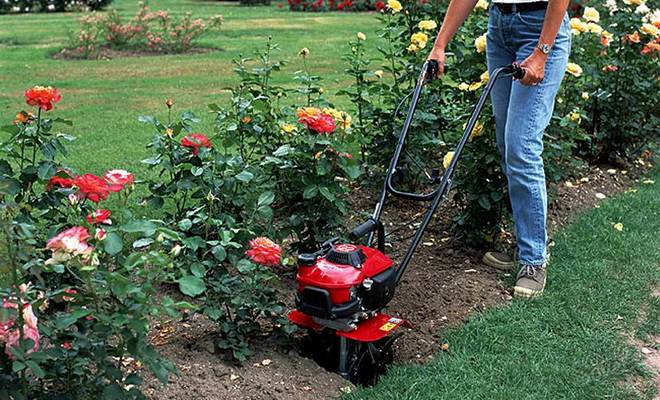
It is necessary to consider what a cultivator is and what types it comes in. Main varieties:
- lightweight products;
- medium cultivators;
- heavy units.
The weight of lightweight devices does not exceed 30 kg. They are designed for processing small areas (up to 10-12 acres). The averages are calculated for plots of 45-50 acres. They weigh approximately 90 kg. Heavy units process areas of more than 50 acres. Their weight is about 100 kg.
Motor cultivators run on gasoline or electricity. Electric machines are easy to operate and do not require special care. More complex gasoline units. They require constant monitoring of the oil and fuel levels in the tanks. It is necessary to follow some rules when cultivating a garden with a cultivator:
- before purchasing a unit, you need to familiarize yourself with its main characteristics;
- on a hilly area you can use equipment that works on slopes exceeding 20°;
- heavy and medium-weight vehicles must be equipped with a reverse function;
- It is advisable to have an emergency brake lever;
- The more speeds the unit has, the more convenient it is to work with it.
A correctly chosen device always keeps the garden in order.
Choosing a cultivator
The main purpose of this technique is to level and loosen the soil. At the same time, it destroys weeds, breaks up lumps, stirs fertilizers and soil. And if the cultivator is small, then it can be used to care for the flower bed.
There are three types of technology:
- Light or manual cultivators - they cultivate land up to 12 acres, their weight is not large, the maximum is 30 kg.
- Medium - designed for a plot of up to 50 acres, they are heavier, their weight reaches 90 kg.
- Heavy or motorized cultivators - this equipment is intended for large vegetable gardens, more than 60 acres, their weight is from 100 kg. Heavy cultivators come with different attachments, so the scope of their work is varied.
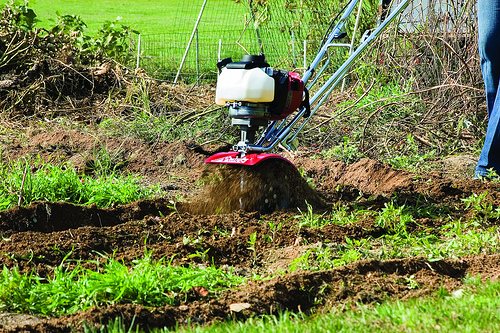
Before you buy a cultivator, read reviews about it. Its work is influenced by two points:
- The grip width is determined by the width of the cutters, so if your area is not level, then you need to immediately buy a set of cutters. In addition, you also need to consider what kind of soil. For example, clay is more difficult to work with than sand. And work on virgin soil is carried out using a special cutter.
- Power. If you need a powerful unit, then give your choice to heavy cultivators.
The equipment can be powered by electricity or gasoline. For small areas, lightweight electric cultivators are usually used; they are easy to operate and do not require special care. The situation is more complicated with gasoline units; before starting work, you need to check the oil level. A two-stroke cultivator uses more gasoline than a four-stroke one. And this technique is very noisy.
When choosing a cultivator, pay attention to the following points:
- If your site consists of hills, then ask your consultant about the possible angle of inclination. Because there are models that work on any slope, and there are those that work at an angle of no more than 20 degrees.
- If you choose medium or heavy equipment, then make sure that it has a reverse gear.
- It’s good if the cultivator has several speeds, so it can be used for different purposes.
- For safety, it is better to opt for cultivators with a special lever, rather than a push-button one, since for emergency braking you will only need to pull the lever towards you, while in the other option you will need to press the button until the vehicle stops completely, and this is not always convenient.
- Similar models may have completely different basic equipment, so before purchasing, carefully study the instructions, which tell you what is included in the kit.
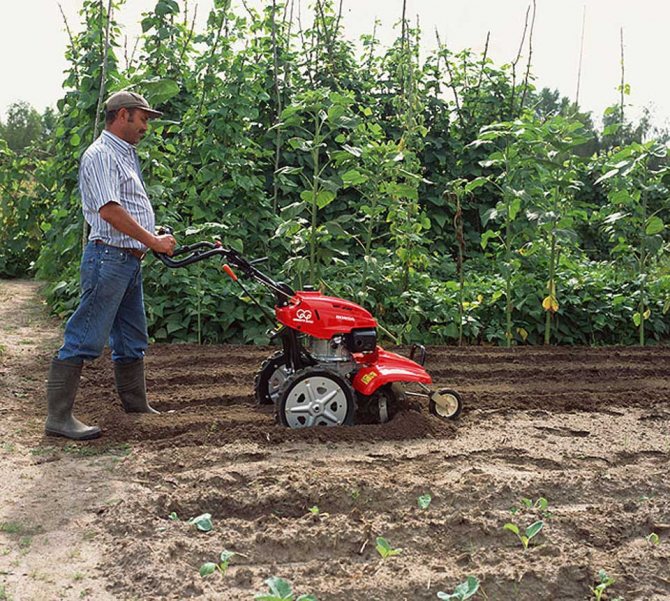
Before using the equipment, walk around the area you will be cultivating and check that there are no foreign objects on it that could damage the cultivator or cause injury to the worker. Read the instructions carefully and follow the recommendations for use. After work, you need to drain the gasoline or refine everything to the last drop. Wipe the entire surface of the unit and apply a thin layer of oil to the metal parts. It must be stored in a dry and clean place. Prices for cultivators vary depending on power; light ones can be purchased for RUR 5,000. This is the case with an electric unit; gasoline units are more expensive, but up to 20,000 rubles. Medium and heavy ones can be bought from 10,000 to 40,000 rubles.
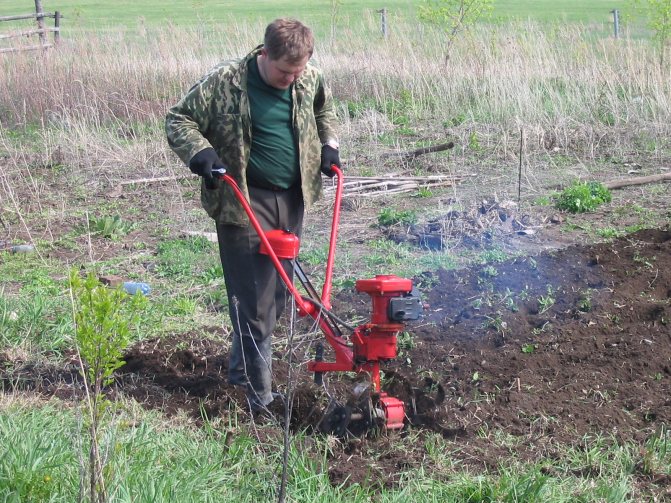
Popular models of cultivators and walk-behind tractors
There are a lot of similar equipment sold in stores. To know which models are the most popular today, let’s take a look at some of them. Lightweight walk-behind tractors are equipped with an engine power of up to 5 hp. With. This technique is not suitable for working with a plow. It is designed to work in a small area. A middle class car is heavier and more powerful. Its cost is higher. A heavy walk-behind tractor weighs up to 200 kg. A seat is attached to it. Heavy machines include Profi PR 1040E. This mini tractor has a 600 cm³ engine. Its power is 10 hp. With.

The large weight (300 kg), size and cost (over 100 thousand rubles) do not add to the popularity of the unit. Our gardeners most often purchase other equipment, including:
- Neva MB-1B-6, OFS. Consumers have been using this unit for a long time. He doesn't have any transmission problems. Spare parts are sold in stores. Replacing them is not difficult. The engine runs on gasoline and has a power of 6 liters. With. The price of the product is about 46 thousand. Reviews from owners indicate that after 300 hours of hard work the power does not drop. The machine is maneuverable, works both in the garden and for transporting goods. The model is equipped with headlights and a three-speed transmission.
- Agate KhMD-6.5, weight - 85 kg. The diesel engine develops a power of 6.5 liters. With. Gear shifting is done from the handle. Advantages of the model: good traction, low gear. Disadvantages: manual start, few functions performed. Cost - 30 thousand.
- Belarus 09N-01. The device is widely used among gardeners. Production started in 1991. Many years of operating experience allowed us to get rid of all the shortcomings. The gasoline engine is equipped with a transmission with two rear and four forward gears. There is a locking differential and a power take-off shaft. The machine is reliable, powerful, with good efficiency and high quality assembly. It costs about 80 thousand.
You can purchase additional attachments for walk-behind tractors to perform various jobs: plows, cutters, hillers, potato planters, seeders, waste shredders, trailers, mowers, tedders and other devices.
Choosing a walk-behind tractor
The main task of the walk-behind tractor is to cultivate the land, but in addition to this, you can cut the grass, dig potatoes and do many other garden works. If you decide to purchase a walk-behind tractor, you need to understand its main characteristics:
- Power. The larger the area of the treated area, the higher the power of the unit should be.
- Fuel. Walk-behind tractors use both gasoline engines, which operate more quietly and can be started even in winter, and diesel engines, which have lower fuel consumption. If a gasoline walk-behind tractor can help you in small areas with good soil, then for a larger area it is better to immediately take a diesel one.
- Weight. The less weight, the easier the grip. Wheel weights are also sold, but without a starting light weight they are ineffective.
- Working width. The greater the width of the cutter, the larger the area processed. The cutter must be dismantled. In this case, you can remove part of it and walk between the rows with a walk-behind tractor. But here you need to take into account that the wider the cutter, the less the soil is processed in depth and the greater the load on the shoulders and back.
- PTO. It is found in all walk-behind tractors and is needed for aggregating attachments.
- Price. The price of a walk-behind tractor depends on the manufacturer; reputable brands are more expensive than products from Chinese companies. But there is a noticeable difference only between professional models, so it is not always worth focusing on the brand; it is better to read user reviews. The cost of a walk-behind tractor starts from 20,000 rubles and above.
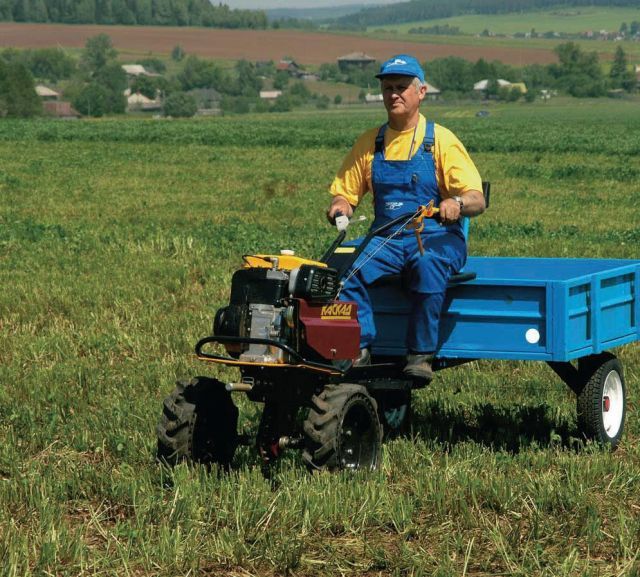
There are also motor cultivators. They are designed for work without heavy loads, with a passive cutter. The advantages of this type of equipment are its compact size and ease of operation; even a woman can use a motorized cultivator. When choosing a walk-behind tractor, be guided by your plot of land. If it is not large and you do not need to do a lot of work in it, then you can choose a small-sized walk-behind tractor or a medium-sized one. Using this technique, you can plow, loosen, and cultivate the land. It will become an indispensable assistant for the garden during the harvesting of fruits and vegetables. Due to its small size, it will be able to deftly maneuver between trees and other garden obstacles and transport the fruits to their place. If the plot is up to 50 acres, then you need a medium walk-behind tractor. It has a more massive appearance and is more difficult to control. Therefore, you will have to practice and adapt a little to work with it. The working width of this model is from half a meter to a meter.

Today in the store you can be offered interesting models of walk-behind tractors that have electric start or headlights to work at night; knives for digging ditches. All these devices, of course, affect the price. Walk-behind tractors have a frequently occurring problem: when operating belt drives, the gearbox may fail. If you don’t need downtime in your work, then buy imported walk-behind tractors; if repairs are not terrible, then you can do a cheap one. Of all the models, Japanese ones are the most reliable. When choosing equipment, look at the components; the most common ones that you will most likely need are a trailer, a hiller and a plow. All other components can be purchased as needed. Ask the seller about the warranty period and service, and also check the basic equipment. Check whether the gearbox can be repaired if it breaks down, because on some models it has to be completely replaced, which is time-consuming and expensive.
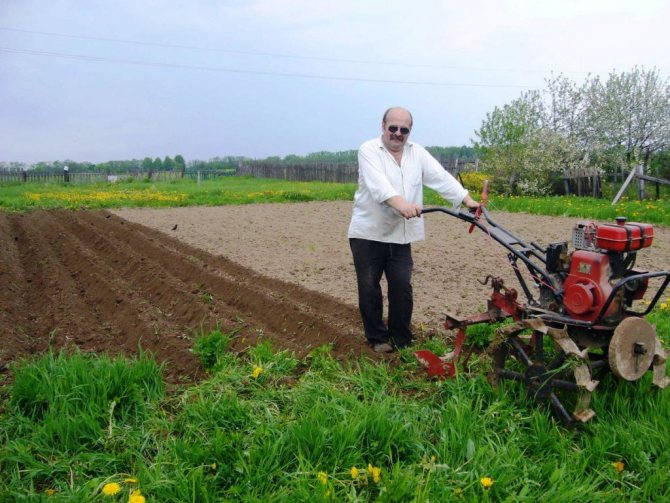
Walk-behind tractor or walk-behind cultivator - which is better?
More and more often, mechanization means are coming to the aid of summer residents, helping to solve labor-intensive and routine tasks. Every spring, the characteristic roar of engines is heard in dacha plots as people plow their plots with walk-behind tractors and motor-cultivators, preparing the soil for planting crops. If you can’t imagine a holiday in the country without growing potatoes and snacks, a walk-behind tractor or motor-cultivator will become your indispensable assistant in spring and autumn. How to choose the right walk-behind tractor - this will be discussed in this article.
The difference between a walk-behind tractor and a cultivator
First of all, you need to know how a walk-behind tractor differs from a walk-behind cultivator. The main difference is that the walk-behind tractor performs all operations while moving on its own wheels. The wheels are “mounted” on the power axle, and all attachments are driven by the power take-off shaft.
It is easier to work with a walk-behind tractor than with a motor-cultivator - you set the soil cultivation depth, engage the clutch, and then the device does everything itself, your task is only to correct the direction of its movement.
The motor-cultivator does not have driving wheels and the cutter is attached directly to the power axis. When working with a motor-cultivator, great effort is required, however, it is significantly lighter and cheaper than a walk-behind tractor.
First of all, when choosing a motor-cultivator/walk-behind tractor, you need to decide exactly what functions you need. In the basic configuration, almost all units can perform plowing and loosening of the soil.
For additional money, you can purchase attachments for hilling, digging up potatoes, processing narrow rows, plowing with a plow, transporting a trailer, and much more.
An important point is that some single-speed motor cultivators are equipped with wheels with a diameter of 20-30 centimeters, which are placed on the power shaft and at the same time the possibility of plowing with a plow, planting and harvesting potatoes is declared.
Keep in mind that at a shaft rotation speed of 115-150 rpm, the speed of the motor cultivator will be about 10 km/h (this is 2 times the walking speed) - you will have to run after the motor cultivator. There can be no talk of any plowing with a plow, much less harvesting potatoes. To perform these operations, a reduction gear is needed.
Keep in mind that when choosing a walk-behind cultivator/walk-behind tractor, you need to take into account the size of your plot. Often, in small areas, every square meter is occupied and pinpoint precision is needed when cultivating the land. Under these conditions, a large-sized unit is inappropriate - you get an analogy with an elephant in a china shop.
Some motor cultivators have reverse speed, or reverse. This is a very convenient thing, especially when processing areas of complex shape. If there is no reverse, you will have to carry the cultivator manually. After several hours of such work, your back is guaranteed to ache. For walk-behind tractors, reverse gear is required.
Decide on the cutting width of the cutter. The wider the grip, the faster the processing. If you need to cultivate large areas, it is better to purchase a motor-cultivator / walk-behind tractor with a working width of 50-80 cm. To cultivate areas of up to 20 acres, you can stop at a working width of 36-40 cm. Keep in mind that “wide” units do not have the ability to process row spacing . A motor cultivator with a working width of 36-40 cm can process row spacing with a width of 16 centimeters using a special cutter.
When choosing engine power, it is better to be guided by the principle of reasonable sufficiency. As power increases, the dimensions of the unit usually increase. For a small area, a lightweight walk-behind tractor with a 3.5-4 hp engine is preferable. As a rule, the unit is small in size, which allows not only plowing the area for potatoes, but also loosening the soil around apple trees, cultivating row spacing, etc. A medium or heavy, and therefore powerful, walk-behind tractor/motor-cultivator will simply be cramped in a small area.
The choice of the country of origin of the unit is now practically not worth it - the vast majority of motor cultivators/motoblocks are produced in China, at least in the budget segment. Naturally, if possible, it is better to buy a “white-assembled” unit, but such offers, as a rule, are only available in the top class.
We consider it our duty to warn you against purchasing motor cultivators/motoblocks in self-service hypermarkets. As a rule, units sold in such stores do not undergo pre-sale preparation; they are sold in the form in which they came from the factory. There is no talk of any adjustment or configuration.
A walk-behind tractor with an unregulated carburetor may stall at idle and not develop full power during operation. It is quite possible that if you bring such a unit to your site several tens of kilometers away, you simply will not be able to start it (there is such a bitter experience!).
If you do not have experience adjusting the carburetor, you will most likely have to take the unit to a service center. It is better to buy motor cultivators in specialized stores, which also provide service and warranty service.
Settings
When installing this tool, the plowing depth is adjusted. To set it up, you need to select a stand for the plow with a height equal to the required depth. In the pre-planting season, the recommended depth is from 10 to 20 cm, and in preparation for winter - up to 25 cm. After this adjustment, the structure of the motor cultivator and plow is partially fixed with a fastening bolt. Then the bolts adjust the inclination of the tool, at which the heel of the plow takes a position parallel to the ground.
Now you can adjust the angle of the blade, which does not have specific parameters. This is simply a user-friendly position. The coupling fasteners should be slightly loosened when performing these manipulations.
The last step is to establish the position of the plow handle that will suit the user's height. Then you can tighten the fasteners tightly and carry out a test plowing.
Design: how are they different?
In appearance, the design of these units is very similar. Except that the walk-behind tractor looks more solid and larger. Although, some models of heavy gasoline cultivators are not inferior to it in size and weight. So what is the difference between a cultivator and a walk-behind tractor?
To put it very simply:
- The cultivator loosens the top layer of soil. Moves forward due to the rotation of the cutter. With attachments, it hills, flies between rows, and digs up root crops.
- A walk-behind tractor is a self-propelled vehicle with a wheel drive. It can move forward and backward (essentially it is a vehicle). And then, depending on the installed attachment, it does everything that is needed on the land plot. And not only on land. He will remove snow, mow grass, sow and harvest crops and transport cargo.
As you can see, a walk-behind tractor is a much more complex technique. Practically, this is a small tractor, or rather its front half. It’s not for nothing that people affectionately call such a machine a “tractor.” And, even if such a device looks lighter and smaller than a gasoline cultivator, it is still on wheels and has the ability to drive independently, and quickly. It also demonstrates the ability to drive back and, if the wheels are locked, to turn around in a few seconds. The engine of the walk-behind tractor is internal combustion only. There are no electric models, unlike the cultivator. The most powerful units are equipped with water-cooled diesel engines. Light vehicles are usually equipped with a four-stroke air-cooled gasoline engine. Expensive devices have a unique element - a power take-off shaft. It significantly expands the functionality, allowing you to attach complex attachments. We decided to compare the walk-behind tractor and cultivator according to the most important parameters, which will definitely help you with your choice.
Plowing the land
Despite the fact that this process does not raise any questions for most farmers, there are several important points in the work that will help its quality implementation.
First you need to place the walk-behind tractor on the outermost part of the field and engage maximum gear. It will be easier for the machine and the user to move and lay the first furrow. The speed of work should be minimal, which will help to immediately assess the depth of processing, the evenness and smoothness of the movement of the equipment.
If the walk-behind tractor with the attached unit jerks or does not go deep enough into the ground, then it is necessary to stop work and make additional adjustments.
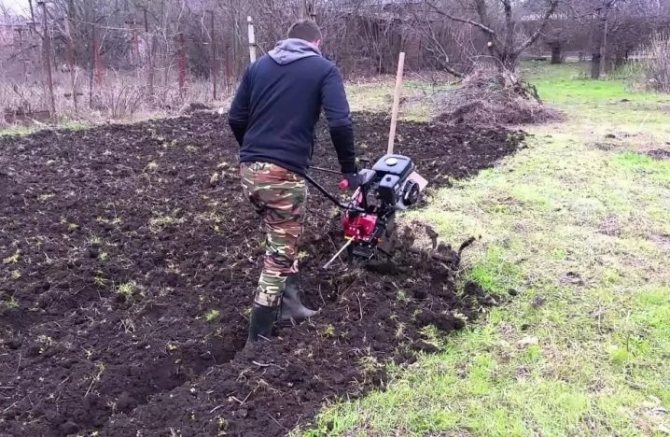
Once you are satisfied with the settings, you can begin processing the entire area of the site. Each time you reach the opposite part of the field, you must turn in the opposite direction and move back along the furrow you just made. To perform the work most efficiently, each subsequent pass should be made at a distance of 10 cm from the previous one.
It is important to know that when plowing hard types of soil, it is better to carry out the plowing process twice. If the work involves raising virgin soil, then during the first pass a shallow depth is set, and during the second - a large one. The fertile soil layer will be completely mixed.
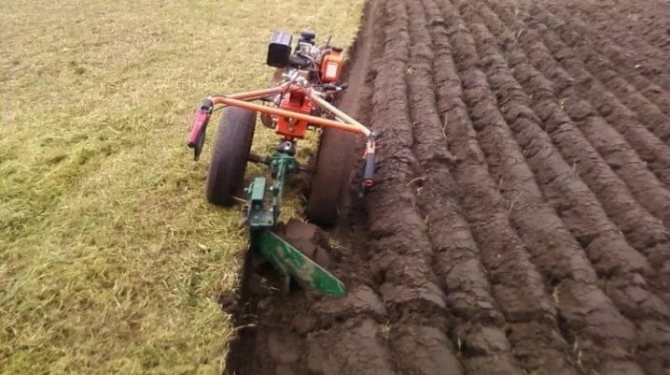
Productivity: who has more
High productivity is the prerogative of walk-behind tractors, since their operating speed is incomparably higher. But thinking that this unit is only for large areas is a mistake. The fact is that, like cultivators, walk-behind tractors vary in engine power. The power of a cultivator is, on average, from 1 to 6 hp, and the power of a walk-behind tractor is on average from 6 to 13 hp. Electric cultivator models are characterized by a power of up to 2.5 kW. Therefore, the cultivator cannot compete with heavy and powerful walk-behind tractors in terms of power and productivity. Moreover, if the land is virgin (uncultivated), then only the most powerful soil cultivator can pull it out, and even then it will be an extra load for it, but the walk-behind tractor can handle it without problems.
The cultivation area is also very different: cultivators can work on areas only up to 20 acres, but walk-behind tractors can handle areas over 30 acres. In simple words, the cultivator is ideal for owners of dachas and suburban areas, and the walk-behind tractor will help small farmers in rural areas cope with the tasks.
Replace the plow with a cultivator
There is no doubt that the plow is one of mankind's greatest inventions. However, apparently, the time has come to reconsider the usual views. Plowing
After conquering the virgin lands, the plow basically exhausted its potential for a positive impact on nature. In recent years, the disastrous consequences of its massive use in agriculture have become increasingly clear: the natural fertility of the land is being depleted, soils are being washed away and eroded, and the Stavropol region is becoming increasingly desertified. This is eloquently evidenced by tens of thousands of hectares of heavily “scalped” lands with outcrops of infertile rocks – stone, sand, clay – on the surface. And this barren desert is growing every year.
Attempts to stop the process of destruction of the once fertile lands of Stavropol began several decades ago. In 1964, for the first time in the European part of the USSR, the region began to use flat-cut cultivators and chisel plows, which made it possible to work using no-moldboard technology and preserve post-harvest residues on the surface. The experiment gave good results and, first of all, made it possible to stop the catastrophic development of dust storms. However, this technology also has drawbacks: using pure steam, it does not guarantee protection of soils from being washed away and blown away.
The solution to the problem is actually simple, like everything ingenious. Centuries of farming experience have shown that it is impossible to come up with something better than nature.
In the 80s of the twentieth century, scientists proposed and then introduced the idea of zero fall tillage. The essence of the know-how was to leave the soil for spring crops and clean fallows untreated in the fall, and to fight weeds with herbicides. Thus, from August to March the soil should remain untouched, in imitation of virgin soil. Or another version of the same technology. If you sow legumes (sainfoin, clover, alfalfa, goat's rue) into spring and winter crops in the spring, then after harvesting the main crop you can save all post-harvest residues and at the same time develop the sowed legumes without any mechanical treatment and, possibly, without herbicides.
By the way, it was the Stavropol residents who were the first in Russia to use zero tillage. This happened for the first time in 1984. Since then, 100-150 thousand hectares have been sown in this way every year. This technology is guaranteed to protect the soil from being washed away and blown away, increases the humus content, improves the water-physical properties of the soil, saturates the soil layer with earthworms, reduces labor, fuel, and energy costs, and helps to obtain stable grain yields from 45 to 60 centners per hectare.
E. RYABOV. Doctor of Agricultural Sciences.
E. RYABOV
Imitate nature / Newspaper “Stavropolskaya Pravda” / November 19, 2008
Control: complexity and convenience
But driving a mini-tractor requires special skills and physical strength. Yes, he performs complex maneuvers and performs tasks unimaginable for a cultivator, but you need to master the science of performing them. In this sense, a cultivator is simpler and lighter. And its dimensions are always more compact. Low- and medium-power models of motor cultivators can be easily transported in the trunk of a car.
To make it easier to operate the walk-behind tractor, manufacturers equip the models with:
- Electric starter. It allows easy starting with the starter key in any conditions.
- Differential lock. One wheel stands still, the other rotates. In this case, the unit easily rotates around its axis without much effort.
Attachments: which ones are installed?
Not every cultivator can work with attachments. There are low-power models with a worm gear that only loosen the soil. Those devices to which attachments can be attached perform separate work: hilling, weeding, harrowing, digging, plowing. However, they need lugs (metal wheels) to increase the severity of the pressure on the soil.
But what distinguishes the “tractor” is that, with the ability to attach attachments, it is a perfect machine. It will perform all of the above tasks. And, in addition, models with a power take-off shaft (PTO) cope well with the so-called “active” hitches. With them they:
- Clean the snow (plough or brush);
- Sow grain (seeder);
- Water the land (irrigator);
- Sweep and wash the street, yard and sidewalk (rotary brush);
- Mow the grass (rotary mower);
- They pierce the lawn to enrich the grass roots with air (aerator shaft);
- They transport cargo to the desired location, weighing 2-3 times more than the unit itself (trailer).
Price: which is cheaper
The design of the cultivator is simpler. The motor, as a rule, is lighter and weaker, which is why this equipment costs less. The difference in price with a walk-behind tractor of similar power is 1.5-2 times.
A heavy six-horsepower cultivator costs about $250, and a 6-horsepower walk-behind tractor of the same power. – 500 USD An electric cultivator can be purchased for around $100, while for a gas cultivator you will have to pay at least $200. Diesel models are even more expensive. Decide what is best to choose based on your financial capabilities.
Motor resource: which equipment is more reliable
Reviews about the reliability of this or that technical device are very different. Overall, this is a relative question. After all, both the walk-behind tractor and the cultivator are equipped with gasoline engines from different manufacturers. If the motor is good, durable and works like a clock, then it will have a longer service life. If the engine is cheap, then the reliability of the equipment decreases several times. In addition, much depends on operating conditions: where and how often the machine operates, what loads it can withstand, what type of soil and size of land plots.
Diesel walk-behind tractors are considered the most reliable and durable. A water-cooled diesel engine has an order of magnitude longer lifespan.
Conclusions: what to buy
Now, understanding what the difference is, you can easily determine by eye where the cultivator is and where the walk-behind tractor is. Which of these units is better cannot be said unambiguously, since each farmer and summer resident has his own area for cultivation and different tasks. For some, a gasoline cultivator is suitable, for others, an electric lightweight device would be the ideal choice, while others only need a functional walk-behind tractor. What to choose depends on the size of the site and priorities. What is most important to you? Lightness, convenience, maneuverability, speed, economy, a wide range of functions?
Some tips for those who doubt their choice:
- If we are talking about beds, flower beds, a vegetable garden on 3 acres, then a lightweight electric cultivator is definitely needed. When loosening in a greenhouse and conservatory, it’s also only him, this is not even discussed, because the room is closed, which means there should be no gases.
- For a vegetable garden remote from the house (6-8 acres), a gasoline cultivator is ideal.
- For a garden of 10-20 acres, you can buy one or the other, look at your wallet and the functions you need. A low-power tractor will cost more, but it will do everything you need in the field, on the lawn, and will become a reliable assistant in the household.
- A plot of 20-50 hundredths can be processed by a heavy walk-behind tractor or cultivator. If the ground is virgin soil, then a wheeled self-propelled unit with a large plowing depth is better.
- Overall field per hectare – no one argues here. Only a functional and high-speed mini-tractor, also known as a walk-behind tractor, can handle such a site.
